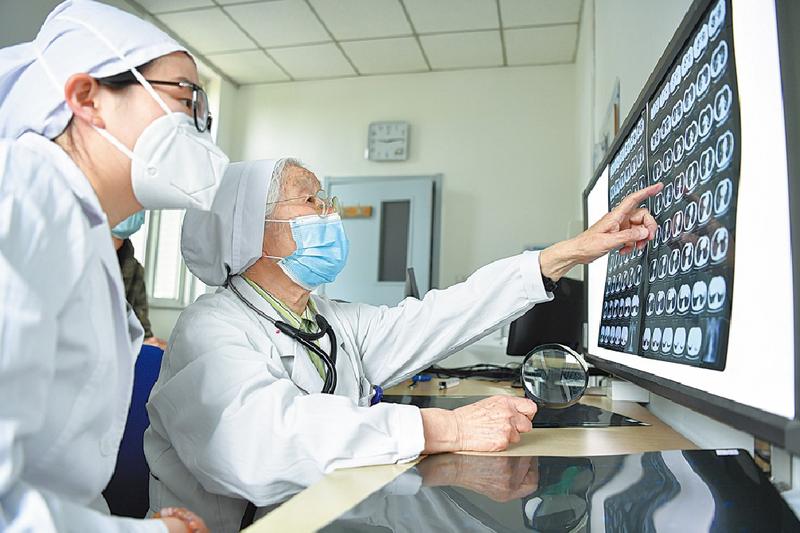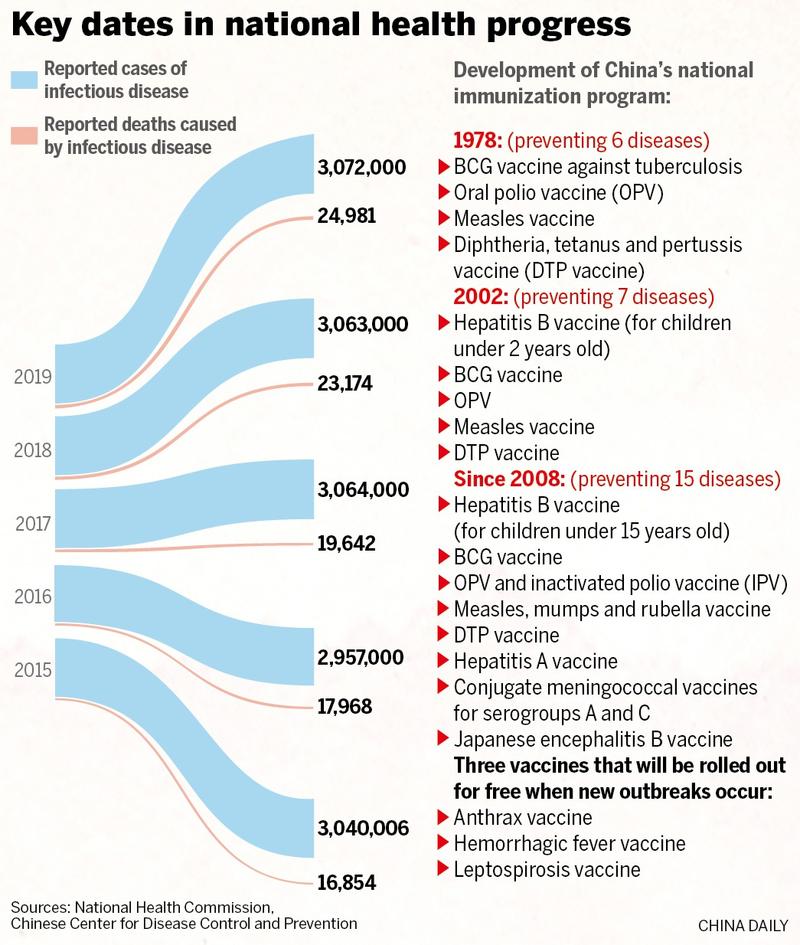 Ma Yu, 89, chief physician of the Capital Medical University's Beijing Chest Hospital, reads CT scans. (PHOTO PROVIDED TO CHINA DAILY)
Ma Yu, 89, chief physician of the Capital Medical University's Beijing Chest Hospital, reads CT scans. (PHOTO PROVIDED TO CHINA DAILY)
Every Thursday morning, a diminutive, silver-haired doctor walks into a diagnosis room at the Capital Medical University's Beijing Chest Hospital. Wearing spectacles, and carrying a magnifying glass and a pointer, she checks for signs of tuberculosis in the CT scans she examines.
Born in 1932, Ma Yu is the chief physician in the hospital's TB department. For more than six decades, she has been on the frontline of battling this contagious disease.
"Some people have said that I should enjoy retirement, but as a doctor, my responsibility is to make correct diagnoses and deliver effective treatments," she said. "I think I will retire naturally when my ability dwindles, and more young talent take my place. The fight against TB is sure to advance, and we are eventually bound to win."
TB is a potentially deadly bacterial infection that can easily be spread through a sneeze, a cough or close contact with contaminated objects.
Although the bacteria usually attacks the lungs, it can also infect other parts of the body, such as the kidney, spine and brain.
Before the 1950s, there were only 12 TB prevention and control institutions in China, with about 120 medical staff. The disease was widely known as the "white plague" because it rendered infected patients pale and weak.
In 1955, Ma graduated from Nanjing Medical University in Jiangsu province and was assigned to the Beijing Chest Hospital, then known as the Central TB Research Institute, and located on the outskirts of the city.
She said that at first, she overlooked the formidable nature of this enemy.
"I thought diagnosing TB was easily done by checking clinical symptoms, chest X-rays and sputum smears. Treatment plans also seemed clear and effective with the use of drugs like isoniazid, streptomycin-isoniazid, and streptomycin," she said. "But reality taught me a hard lesson."
According to the World Health Organization, China is one of the 30 highest-burden countries for TB.
Ma said that for patients, lung infections are usually just the beginning. Severe inflammation of the pleura (the thin layer of tissue that cushions the lungs against the chest cavity), peritonitis, meningitis caused by the bacteria, as well as lymph node TB and hematogenous TB(TB carried through the bloodstream) are among the toughest nuts to crack.

There is an old saying in China that out of 10 people with TB, nine will eventually die from the disease. "Seeing patients deteriorate is the most excruciating sight for a doctor," she said.
The scale of the threat did not demoralize Ma, who was bent on improving existing therapies and exploring new ones.
TB bacteria can destroy surrounding tissue and create cavities in the lungs. When infected patients cough, the bacteria accumulated in these holes is more likely to be expelled and be transmitted to other people.
When TB drugs first became available, the traditional method was oral delivery. But the clinical outcome was limited because the drugs were absorbed via the digestive tract, and so only a limited amount managed to reach the lungs and help close up the cavities.
In the 1950s, doctors attempted to use a nasal catheter to inject drugs into lungs directly.
The method was promising but proved unable to target the holes precisely.
At a time when modern equipment was a scarcity in most Chinese medical institutions, in order to develop a gadget that could shift valves in a desired direction, Ma enlisted the help of a surgeon and two other patients.
One of them, an aircraft maintenance technician, provided Ma with high-quality steel wire that could be used to make an adjustable spring.
The other, who repaired bikes for a living, gave her latex tubes to wrap around the steel as protection.
Ma said the invention of the directional catheters would not have been possible without the collaboration of her fellow doctors and the two patients, who pooled limited resources to work together toward conquering the disease.
Because of the insufficient daytime supply of electricity at the time, Ma sometimes had to begin treatment at four in the morning.
"I remember as it got closer to 4 am, patients waiting in the corridor would whisper to each other, 'let's quiet down so Doctor Ma can sleep a while longer'," she said.
One patient who benefited from the new technique kept in touch with Ma. In one letter to the patient, Ma wrote that "seeing patients receive the correct diagnosis and successful therapy is our greatest joy, and the spiritual anchor that motivates me to work harder".
Thanks to the firm conviction and dedication of healthcare workers like Ma, as well as improvements to the national TB prevention and control system, China's TB mortality rate has declined continuously, reaching 2.2 per 100,000 people in 2019. According to the WHO, the country has now dropped to 30th on the list of 30 high-burden countries for the first time.
With the development and rollout of more advanced tools, Ma said the age when doctors were constantly baffled and dismayed by poor diagnoses had passed, and Chinese TB patients have access to most drugs available globally.
Some things haven't changed though, such as Ma's heartfelt respect and genuine care for patients.
In the past, she had to trek to remote areas to visit rural patients, enduring rain and sunshine while grappling with outdated equipment and the shortage of medications.
Her team was used to putting spare change in their medication kits to help patients who could not cover the full cost of treatment.
Ma also developed the habit of warming up the stethoscope with her hands before placing it on a patient's chest or back, so that they wouldn't feel cold.
As she has said previously, "the doctor's greatest enemy is aloofness, and their best prescription is love".
On April 24, Peng Liyuan, wife of President Xi Jinping and the World Health Organization's Goodwill Ambassador for tuberculosis and HIV/AIDS, said in a reply to Ma Yu that she admired and was touched by her deeds.
"You have worked in the field of tuberculosis diagnosis and treatment, scientific research and education for 60 years and you have always been fighting on the frontline against the disease," the letter said.


